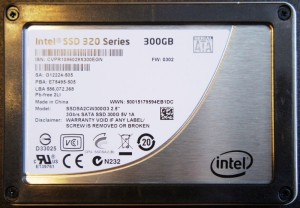
Every so often a subject presents itself that, on the surface, leaves people wondering what the heck the company had in mind when they started the production line rolling.
The 320 Series SSD seems to be just that as word of this SSD was leaked a few weeks back and the technology community seems to think Intel would be crazy to release this in a time of so many SATA 3 SSD releases. What the heck is Intel thinking?!?
This past week we had the opportunity to speak with Troy Winslow, Intel NAND Group Marketing Manager, with respect to just this and we were also able to put this new Intel release through the paces first hand to see what the buzz was really about. Troy reminded us that we might take a look at the bigger picture which was that this is Intels third release in three months and that there is a large segment of present SSD users, as well as those migrating to SSDs, that still rely on SATA 2 computers. Hence, there just may be a key audience for the Intel 320 Series SATA II SSD.
INTRODUCTION
The Intel 320 Series SSD is available in capacities of 40, 80, 120, 160, 300 and 600GB in the 2.5” form factor and capacities of 80, 160 and 300GB in the 1.8” form factor. This is beneficial as it now allows many ultra portables to migrate to SSD without losing storage capacity as was the norm previously with 1.8” equipped systems. High sequential read performance is 240MB/s for the 40 GB size and 270MB/s for all remaining sizes.
Write performance increases with size with speeds of 45MB/s (40GB), 90MB/s (80GB), 130MB/s (120GB), 165MB/s (160GB), 205MB/s (300GB) and 220MB/s (600GB). Random 4k IOPS also increase with capacity and the 320 Series can reach a maximum of 39500 IOPS read and 23000 IOPS write. This release is also equipped with AES 128 bit encryption for data security as well as data protection that prevents loss of data in the cache in the event of a power loss.
PHYSICAL CHARACTERISTICS
The Intel 320 Series SSD is controlled by Intels own PC29AS21BA0 controller which did very well in the previous generation X25 series of solid state drives. The key to this new generation is Intels introduction of their own 25nm NAND memory chips (29F16B08CCMEI) which permit a greater overall capacity for the drive. Our drive comprises of 10 chips on each side of the PCB, each being 16GB in size for a total of 320GB RAW capacity, 20GB being proprietary to the SSD itself for firmware and over provisioning.

 Over provisioning allows for increased life and performance of the drive but a unique feature is its ability to map a cell of the over provisioned block to the available capacity should a failure of a user cell occur, this all without the knowledge or worry of the user. This is similar to the occurrence of hard drive corruption yet different, in that, there is no performance loss or potential loss of data as a result. 279GB of storage is available to the user once the 320 is formatted.
Over provisioning allows for increased life and performance of the drive but a unique feature is its ability to map a cell of the over provisioned block to the available capacity should a failure of a user cell occur, this all without the knowledge or worry of the user. This is similar to the occurrence of hard drive corruption yet different, in that, there is no performance loss or potential loss of data as a result. 279GB of storage is available to the user once the 320 is formatted.
SPECIFICATIONS
Model Name: Intel Solid-State Drive 320 Series
Capacity: 40GB, 80GB, 120GB, 160GB, 300GB, 600GB
NAND Flash Memory: 25nm Intel NAND Flash Memory Multi-Level Cell
Sustained Sequential Reads (up to):
40GB: 200 MB/s ~ 80GB: 270 MB/s ~ 120GB: 270 MB/s ~ 160GB: 270 MB/s ~ 300GB: 270 MB/s ~ 600GB: 270 MB/s
Sustained Sequential Writes (up to)
40GB: 45 MB/s ~ 80GB: 90 MB/s ~ 120GB: 130 MB/s ~ 160GB: 165 MB/s ~ 300GB: 205 MB/s ~ 600GB: 220 MB/s
Read Latency: 75 us ~ Write Latency: 90 us
Random 4KB Read IOPS (up to)
40GB : 30,000 IOPS ~ 80GB: 38,000 IOPS ~ 120GB: 38,000 IOPS ~ 160GB: 39,000 IOPS ~ 300GB: 39,500 IOPS ~ 600GB: 39,500 IOPS
Random 4KB Writes (up to)
40GB: 3,700 IOPS ~ 80GB: 10,000 IOPS ~ 120GB: 14,000 IOPS ~ 160GB: 21,000 IOPS ~ 300GB: 23,000 IOPS ~ 600GB: 23,000 IOPS
Interface: SATA 3Gb/s, compatible with SATA 1.5Gb/s
Form Factor: 2.5 inch ~ Capacities: 40GB, 80GB, 120GB, 160GB, 300GB, 600GB
Form Factor: 1.8 inch ~ Capacities: 80GB, 160GB, 300GB,
Height / Weight: (2.5) 7.0mm / 82 grams 9.5mm / 88 grams (1.8) 5.0mm / 49 grams
Life Expectancy: 1.2 million hours Mean Time Between Failures (MTBF)
Power Consumption: Active: 150 mW Typical ~ Idle: 100 mW Typical
Operating Temperature: 0°C to 70°C

No comments:
Post a Comment